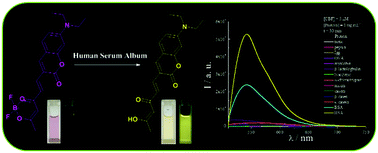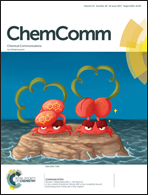A fluorescence turn-on probe for human (bovine) serum albumin based on the hydrolysis of a dioxaborine group promoted by proteins†
Abstract
A fluorescence “off–on” probe CBF, constructed by incorporating a dioxaborine unit into a microenvironment-sensitive fluorophore, was developed for serum albumin (SA). Upon binding to SA, the dioxaborine group in CBF was hydrolyzed into β-diketonate, which triggered dramatic fluorescence enhancement (over 1000-fold) along with a remarkable blue-shift (∼100 nm). The bioimaging results suggested that more SA were taken in by cancer cells.



 Please wait while we load your content...
Please wait while we load your content...